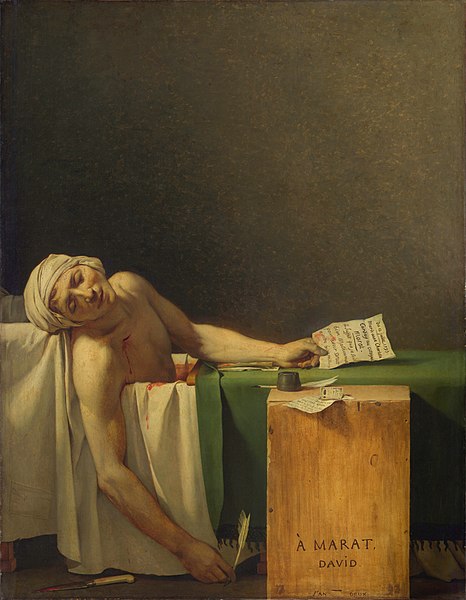Jacques-Louis David, Death of Marat

When the French Revolution broke out in 1789, David threw in his lot with the Jacobins, the radical and militant revolutionary faction. He accepted the role of de facto minister of propaganda, organizing political pageants and ceremonies requiring floats, costumes, and sculptural props. David believed that art could play an important role in educating the public and that dramatic paintings emphasizing patriotism and civic virtue would prove effective as rallying calls. However, rather than continuing to create artworks focused on scenes from antiquity, David began to portray scenes from the French Revolution itself.
In 1793, David painted Death of Marat, which he wanted not only to serve as a record of an important event in the struggle to overthrow the monarchy but also to provide inspiration and encouragement to the revolutionary forces. The painting commemorates the assassination that year of Jean-Paul Marat (1743-1793), an influential writer who was David’s friend. The artist depicted the martyred revolutionary still holding a quill pen in his right hand after Charlotte Corday, a member of a rival political faction, stabbed him to death while Marat was immersed in a bathtub as he worked. (Marat suffered from a painful skin disease and required frequent medicinal baths.) His “desk” was a board placed across the tub with a wood stand next to it for his writing materials. David presented the scene with directness and clarity. The cold neutral space above Marat’s figure slumped in the tub produces a chilling oppressiveness. The painter vividly placed all narrative details in the foreground – the knife, the wound, the blood, the letter with which Corday gained entrance – to sharpen the sense of pain and outrage. David masterfully composed the painting to present Marat as a tragic martyr who died in the service of the revolution. Indeed, the writing stand, which bears the words “To Marat, David,” resembles a tombstone, and David based Marat’s figure on the dead Christ in Michelangelo’s Pietà in Saint Peter’s in Rome. The reference to Christ’s martyrdom made the painting a kind of “altarpiece” for the new civic “religion,” inspiring the French people with the saintly dedication of their slain leader.[1]
- Fred S. Kleiner, Gardner’s Art Through the Ages: The Western Perspective, vol. 2, 15th ed., (Boston: Cengage Learning, 2017), 665-666. ↵

